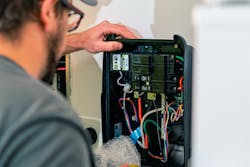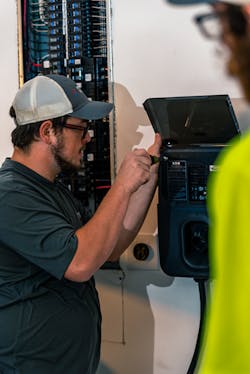EV Installations on the Home Front — Part 2 of 4
The rise of electric vehicles (EVs) is ushering in a brave new world for both homeowners and electrical professionals. EVs are at the forefront of advancing the energy transition and reducing the world’s reliance on carbon, as the number of passenger EVs on the roads is expected to triple by 2025. They also drive important considerations for electrical professionals tasked with installing charging infrastructure, particularly in single-family homes.
In part one of this series, featured in the May 2023 issue and online at https://ecmweb.com/21264841, we focused on key energy capacity factors to consider when installing EV charging infrastructure in a home environment. This includes ensuring adequate grid-level capacity to meet charging requirements and understanding the role contractors can play in educating homeowners about smart energy management and charging capabilities. Next, we’ll take a closer look at another critical factor: safety.
New frontier, unique applications
Compared to other residential power requirements, EV infrastructure represents a large electrical load in the home. As with any installation, safety is paramount, and there are distinct considerations for EV charging applications.
U.S. homeowners plug in and unplug 120V loads every day. However, for larger loads like air conditioners, electric stoves, or dryers (which are 240V), homeowners rarely interact with the power that feeds them. EVs represent a change in this routine, with EV charging infrastructure representing a 240V load that homeowners will interact with daily.
Another consideration is the time of operation. Unlike many home appliances and systems, EV charging is a continuous load that runs until the vehicle is charged — a process that can take anywhere from five to 10 hours. In most applications, homeowners charge their vehicles overnight, making safe installation and operation even more critical.
Environment is yet another factor that differentiates EV charging, as impacts from heat, humidity, and snow will vary based on whether the charger is installed indoors or outdoors.
“EV charging infrastructure represents a new frontier for electrical professionals,” says Adam Schmitt, commercial service electrician at Ferry Electric Company in Pittsburgh, who has extensive installation experience. “Professionals should take the time to understand the unique aspects of these solutions and take a thoughtful approach to ensuring safe installation and operation.”
Electrical professionals should apply the following considerations when undertaking EV installation projects.
Talk to the homeowner
First and foremost, the installation and operation of EV equipment is an opportunity for electrical professionals to educate homeowners and gain their trust at every step of the process. A key element in establishing trust is understanding the unique aspects of each application and sizing infrastructure in a way that prioritizes safety.
For example, homeowners have different needs for vehicle charging speed, which, in turn, will have an impact on the size of the load. By speaking to the homeowner early in the process and educating them about available options, electrical professionals can help guide them to the size charger that best fits their needs — and which won’t overload their system based on expectations of charge time. If the homeowner expects to charge overnight for eight to 10 hours, then a 7.7kW charger may be appropriate. If they need a faster charge time, they may want to install a 19.2kW charger. Most charging equipment comes with built-in ground-fault protection and other safeguards; however, contractors should ensure that these safety measures are properly installed and tested.
Additionally, having a conversation with homeowners can help educate them about practical considerations for daily use. If the homeowner wishes to install EV charging infrastructure in a garage, for example, a contractor should talk through the preferred location to provide the safest path to the vehicle. They can also advise on issues such as cord length and storage best practices, which can help mitigate potential issues like tripping hazards or the cord getting caught on the vehicle itself. Professionals should ask about specific applications and steer users toward the best installation options to help reinforce long-term safety practices.
Execute a plan
Once the contractor and homeowner are aligned on expectations, make a plan for installation that places safety at the top of the priority list.
Wiring in older homes can vary depending on a variety of factors — such as when and how the original system was built and whether the wire is copper or aluminum — so begin by carefully reviewing existing electrical systems/wiring and taking the necessary steps to address any issues (Photo 1). Ensure the panelboard can support the continuous load of the charging infrastructure, and use a circuit breaker sized to protect the wiring and the load.
Additionally, even though vehicle chargers are required to have ground-fault protection, there may be additional ground-fault requirements when installing these units. For example, ensure that the appropriate ground-fault protection is applied at the panel or subpanel when that panel is feeding a receptacle powering a wall-mounted charger in a garage or other location. It is also helpful to determine whether the homeowner plans to eventually install a second charger. If so, make the necessary adjustments to the electrical system and future-proof the home to handle the additional load. Realistically, contractors should anticipate this being the case as nearly 40% of U.S. homes had at least two vehicles as of 2021.
Finally, many homeowners will need to install infrastructure outdoors, leaving the charger open to exposure to dirt, water, ice, and other potential weather impacts (Photo 2). Review opportunities to install some of the equipment inside so the only components exposed to these elements outside are the J1772 connector, cord, and cord-mounting bracket. For wall-mounted units that are designed to be outdoors, contractors should use best practices for sealing any entry and exit points to the home and protect the wires appropriately where the wires enter the charger.
Procure safe equipment, and test it
Taking a wide-angle view of the electrical industry, EV charging infrastructure is still in its early stages with many competing brands entering the space. Sourcing from a reputable vendor and trusted brand with a strong track record of safety helps provide peace of mind that the equipment adheres to stringent industry safety standards. Appropriately designed chargers are developed for continual use and tested for repetitive connection/disconnection operation with conductors that are protected from normal use and wear and strain reliefs to ensure the long life of the equipment.
As is always the case when installing large loads, it is essential to test the equipment and communication system before the homeowner plugs the charger into the vehicle. Test units are available to mimic vehicle connection, ground fault simulation, and other issues to ensure proper operation. Consider aligning with the homeowner on a maintenance plan that allows for routine testing of equipment over the life of their investment.
The future is bright for EVs. With the right equipment, the right plan, and the right approach to educating homeowners about the potential risks, electrical professionals can help ensure homeowners’ investments in infrastructure will provide safe, reliable charging for years to come.
Dan Carnovale is the director of the Eaton Experience Centers in Pittsburgh and Houston. He is a registered professional engineer in the states of Pennsylvania, California and Alaska, a Certified Energy Manager (CEM) and a Senior Member of IEEE. He can be reached at [email protected].
About Eaton Experience Centers
At Eaton’s Experience Centers, visitors learn about industry best practices and the latest innovations through hands-on training in multiple application environments. The Eaton Experience Center in Pittsburgh is a full-scale demonstration and testing facility where visitors can see firsthand the latest advances in electrical power quality, energy management and safety. In this controlled environment, visitors observe product testing and performance, participate in live demonstrations and training courses, and learn about power management technologies from Eaton experts. The goal of Eaton’s Experience Centers is to help take the mystery out of electrical power systems spanning from utility substation equipment to the receptacles in the home. To learn more, visit Eaton.com/Experience.
About the Author
Dan Carnovale
Dan Carnovale is the director of the Eaton Experience Centers in Pittsburgh and Houston. He is a registered Professional Engineer in the states of Pennsylvania, California and Alaska, a Certified Energy Manager (CEM) and a Senior Member of IEEE. He can be reached at [email protected].


